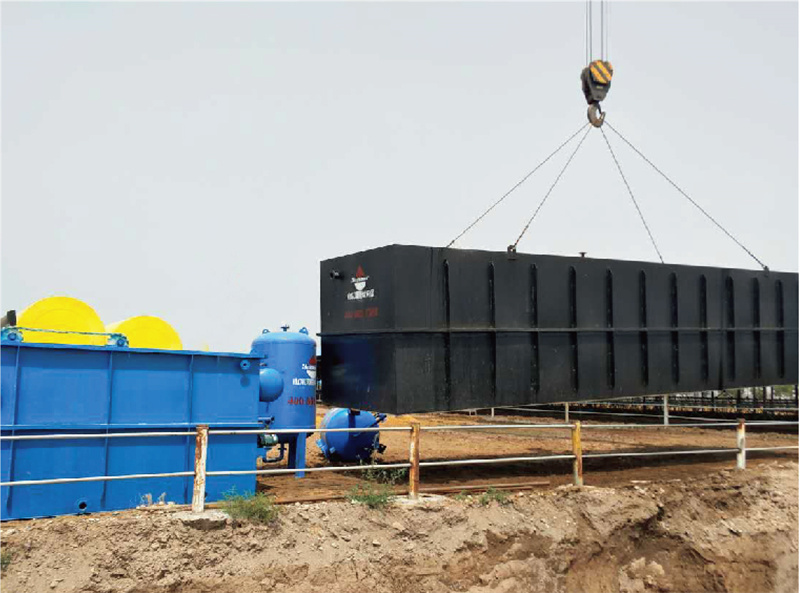News details
On-site Installation Record of Underground Integrated Domestic Sewage Treatment Equipment in Yinchuan, China
Release time:
2025-11-11 13:51
I. Core Advantages of Underground Integrated Domestic Sewage Treatment Equipment
(1) Space-saving and Adaptable to Complex Terrain
Underground integrated domestic sewage treatment equipment adopts underground installation, with the main body buried underground. The ground can be reused for greening, hardening, etc., effectively saving land space. This feature gives it significant advantages in rural areas with tight housing land and complex terrain, as it does not require large-scale land leveling and can flexibly adapt to different geographical environments.
(2) Integrated Design to Simplify Construction Processes
The equipment integrates multiple units such as pre-treatment, biological treatment, and advanced treatment into one, eliminating the need to construct separate structures like grille tanks, grit chambers, and biochemical tanks. This integrated design greatly simplifies the construction process of sewage treatment projects, shortens the construction period, reduces project costs, and minimizes the impact of construction on the surrounding environment.
(3) Efficient Treatment with Up-to-Standard Effluent Quality
Equipped with advanced biological treatment technologies such as A/O process and MBR process, the equipment can efficiently remove pollutants like COD, BOD, ammonia nitrogen, and total phosphorus from domestic sewage. Through reasonable process design and parameter regulation, the effluent quality can stably meet the Class 1A standard or higher in the "Discharge Standard of Pollutants for Municipal Wastewater Treatment Plants" (GB18918-2002), satisfying the requirements for rural sewage discharge or reuse.

(4) Intelligent Operation and Maintenance to Reduce Management Costs
The equipment is equipped with an advanced intelligent control system, enabling real-time monitoring, remote control, and automatic adjustment of operating status. Managers can grasp operating parameters, water quality data, and other information at any time through mobile apps or computer clients, promptly detecting and addressing equipment failures. Meanwhile, the equipment requires minimal operation and maintenance work and no professional team, reducing the management costs of rural sewage treatment.
II. Application Scenarios of Underground Integrated Domestic Sewage Treatment Equipment
(1) Rural Residential Areas
Rural residential areas are relatively scattered with small and fluctuating sewage discharge. Underground integrated domestic sewage treatment equipment can flexibly select models based on the village's population size and sewage discharge, realizing on-site treatment and reuse of sewage and solving the problems of difficult sewage collection and treatment in rural areas.
(2) Small Towns
The sewage treatment demand of small towns falls between cities and rural areas. Traditional centralized sewage treatment plants have high construction costs and large pipeline investment. Underground integrated domestic sewage treatment equipment can serve as a supplementary or alternative solution, especially suitable for small towns with small populations and relatively weak economic foundations.
(3) Tourist Attractions
Sewage discharge in tourist attractions is obviously seasonal and fluctuating, with a significant increase during peak seasons and less during off-seasons. The equipment can flexibly adjust the operating load according to the number of tourists, ensuring effective sewage treatment while avoiding resource waste caused by building large-scale sewage treatment facilities.
(4) Industrial Parks
Some small industrial parks or enterprises have small and relatively stable domestic sewage discharge. The equipment can meet their sewage treatment needs, realizing up-to-standard discharge or recycling of sewage and reducing the environmental protection costs of enterprises.
III. Technological Development Trends of Underground Integrated Domestic Sewage Treatment Equipment
(1) Continuous Improvement of Intelligence Level
With the continuous development of technologies such as the Internet of Things, big data, and artificial intelligence, the intelligence level of the equipment will keep improving. Future equipment will feature more advanced monitoring and control functions, enabling real-time monitoring of water quality parameters, automatic fault diagnosis and early warning, and intelligent optimization of operating parameters, further enhancing operational efficiency and stability.

(2) Continuous Innovation of Process Technologies
To meet higher requirements for effluent quality and lower energy and chemical consumption, the process technologies of the equipment will continue to innovate. For example, new biofilm technologies, advanced oxidation technologies, and membrane separation technologies will be increasingly applied to improve pollutant removal efficiency and reduce treatment costs.
(3) Continuous Enhancement of Resource Utilization
While solving sewage treatment problems, realizing the resource utilization of sewage is the future development direction. Underground integrated domestic sewage treatment equipment will pay more attention to the reuse of treated sewage, such as for farmland irrigation, landscape greening, and flushing, improving water resource utilization efficiency. Meanwhile, sludge generated during treatment will also be recycled, such as being made into organic fertilizer or used for soil improvement, realizing waste-to-treasure conversion.
IV. Conclusion
With its significant advantages of space-saving, integrated design, efficient treatment, and intelligent operation and maintenance, underground integrated domestic sewage treatment equipment provides an ideal solution for rural and other decentralized domestic sewage treatment. As technology advances and application scenarios expand, the equipment will play an increasingly important role in improving rural human settlements and promoting ecological civilization construction. It is reasonable to believe that underground integrated domestic sewage treatment equipment will become the mainstream equipment in the field of domestic sewage treatment in the future, making greater contributions to the sustainable utilization of water resources and environmental protection.
Pre
Related news
Contact: +86 18016210178 (Ms.Liu)
Add:No.56, Donghuan Road, Zhucheng City, Weifang City, Shandong Province











